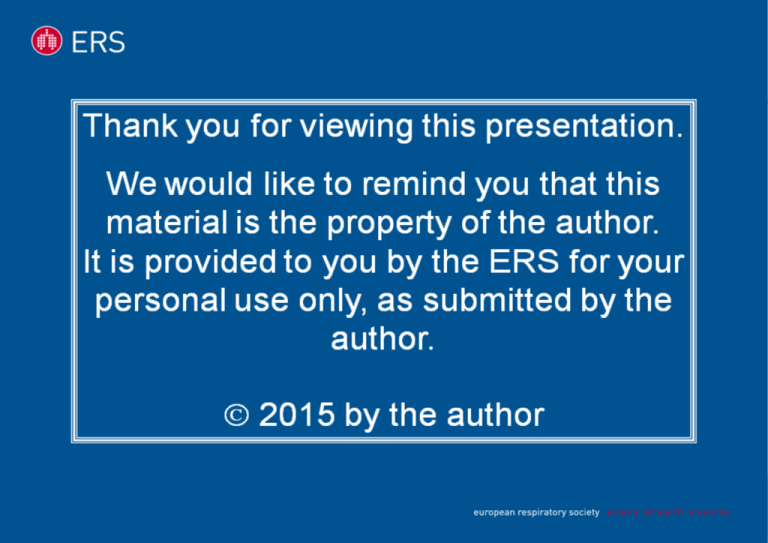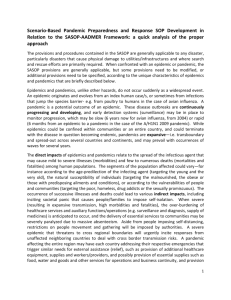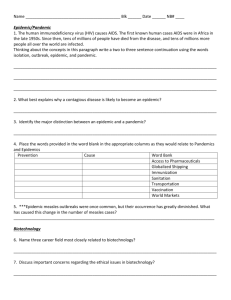
1 │Pandemic and Epidemic Diseases Department │
Global capacity and responses
to pandemics
- WHO's global strategy –
N. Shindo MD, PhD.
Coordinator
Pandemic and Epidemic Diseases Department
Epidemic Clinical Management
ERS International Congress 2015, Amsterdam
2 │Pandemic and Epidemic Diseases Department │
HSE cluster and PED Department
DG
FWC
GMG
IHS
HSE
HTM
PEC
PED
Pandemic and Epidemic
Diseases
FOS
Food safety and zoonosis
GCR
4 │Pandemic and Epidemic Diseases Department │
NMH
Global Capacity and Respnse
How many pathogens able to infect
humans?
HIV (1983)
Discovery curve for human virus species2
Chikungunya
virus
Monkeypox virus
(1972)
(1956)
1Jones,
Hendra virus
(1994)
Ebola virus
(1976-7)
K, Nature (2008)
ME, Proc. R. Soc. B (2008)
2Woolhouse,
1400 pathogens1 are
known to infect human,
other are discovered
/identified every year
Some of them are
responsible of global public
health problems e.g.
SARS, in 2003, pandemic
influenza in 2009
70% from animal origin
5 │Pandemic and Epidemic Diseases Department │
Pandemic and Epidemic diseases
department
Improve shared knowledge and evidence-base for epidemic
diseases to inform policies at international and national levels
Perform timely risk assessment and monitoring of infectious
epidemic diseases of international concern to define
emergency intervention strategies.
Support countries throughout the epidemic cycle:
Preparedness, Response and Resilience to epidemics
Optimize treatments and diagnostics to reduce infectious
diseases mortality
Implement global mechanisms and processes to deal with the
international dimension of epidemic diseases
PED activities
Diseases
Cholera
Emerging diseases
Hendra virus infection
Influenza (avian, seasonal, pandemic)
Leptospirosis
Meningitis
Nipah virus infection
Plague
Rift Valley fever
SARS and coronavirus infections
Smallpox and human monkeypox
Tularemia
Viral Haemorrhagic fevers (Ebola,
Marburg, Lassa, CCHF)
Yellow fever
Cross-cutting initiatives and network
Antimicrobial resistance (AMR)
Battle against Respiratory Viruses (BRaVe) initiative
Communicable Disease Control in Humanitarian
Emergencies (DCE)
Emerging and Dangerous Pathogens Laboratory
Network (EDPLN)
International Coordinating Group (ICG) for yellow
fever, meningitis and cholera
Global Infection Prevention and Control Network
(GIPCN)
Global influenza Surveillance and Response System
(GISRS)
Global Leptospirosis Environmental Action Network
(GLEAN) and Meningitis Environmental Risk
Information Technologies (MERIT) project
Pandemic Influenza Preparedness framework (PIP)
Weekly Epidemiological Record (WER)
7 │Pandemic and Epidemic Diseases Department │
Evidence to reduce
disease transmission
e.g. Role of pigs in the transmission/
amplification of some deadly viruses (viral
haemorrhagic fever, Influenza)
Impact on preventive measures and cross
sectorial work(OIE/FAO)
e.g. Bats in haemorrhagic fever
transmission
8 │Pandemic and Epidemic Diseases Department │
Develop public health research agenda
WHO is streamline research
– How useful it is to stockpile
efforts done by academia or
mask for pandemic
preparedness?
industry to answer public health
– What is the actual risk to
questions
face an avian influenza
pandemic?
– How can we foster research
on new treatments for viral
respiratory diseases to save
700 million children under 5
each year ? (BRAVE
initiative)
9 │Pandemic and Epidemic Diseases Department │
10 │Pandemic and Epidemic Diseases Department │
What do we do ?
Perform timely risk assessment
and monitoring
of infectious epidemic diseases of international
concern
to define emergency intervention strategies.
11 │Pandemic and Epidemic Diseases Department │
12 │Pandemic and Epidemic Diseases Department │
Outbreaks on the African continent (2007-2013)
A total of 174 epidemics
Number of epidemic by year in Africa
Analysis excluded Poliomyelitis, HIV, TB and malaria
A total of 15 diseases cause(d) outbreaks include:
Avian Influenza
Chikungunya
Cholera
Ebola
Hepatitis E
Lassa Fever
Marburg
Meningitis
Monkeypox
Nodding disease
Plague
Rift Valley Fever
Typhoide
West Nile Fever
Yellow Fever
13 │Pandemic and Epidemic Diseases Department │
Source: WHO/PED, March 2013
Number of epidemics
(2007-2013)
The boundaries and names shown and the designations used on this map do not imply the expression of any
opinion whatsoever on the part of the World Health Organization concerning the legal status of any country,
territory, city or area or of its authorities, or concerning the delimitation of its frontiers or boundaries. Dotted
lines on maps represent approximate border lines for which there may not yet be full agreement.
WHO 2013. All rights reserved
Preventive interventions, 2012
Prepositioning of reagents and
treatments:
meningitis
Preventive vaccination
campaigns (GAVI support)
meningitis
yellow fever
14 │Pandemic and Epidemic Diseases Department │
Epidemic responses, 2014
Epidemic responses for
– MERS CoV (Middle East)
– Avian influenza H7N9 (China)
– Ebola (West Africa)
Global stockpile of vaccine and antivirals
15 │Pandemic and Epidemic Diseases Department │
New approaches for old disease:
cholera
Close partnership with water sector to reduce cholera
transmission
Rational use of oral cholera vaccine during emergencies
(e.g. global oral cholera vaccine stockpile)
16 │Pandemic and Epidemic Diseases Department │
What do we do ?
Optimize treatments
and diagnostics
to reduce infectious diseases
mortality
17 │Pandemic and Epidemic Diseases Department │
Differential mortality and access to care
Cholera Treatment Unit (2003)
Hospitalized patient during SARS outbreak (2003)
18 │Pandemic and Epidemic Diseases Department │
Improvement of clinical management and
infection control
Guidance for treatment and
infection control
Access to medicine
(prequalification, essential
list of medicine)
Partnership with experts
networks: ISARIC, INFACT
19 │Pandemic and Epidemic Diseases Department │
Global Health Security
IHR(2005), a paradigm shift
International legal instrument, 194 countries
Aim: help the international community prevent and respond to acute
public health risks that have the potential to cross borders and threaten
people worldwide
Increased emphasis on early source control rather than borders
Applicability to all hazards
From preset measures to adapted response based upon risk
assessment, facilitated by communication
Includes an obligation to build national capacities to detect and respond
to potential public health events
20 │Pandemic and Epidemic Diseases Department │
Implementation of the PIP framework
Sharing
of influenza
Viruses
Sharing of benefits
GISRS
Equal footing
21 │Pandemic and Epidemic Diseases Department │
Vaccines
Antivirals
Diagnostics
Publications
Pandemics of the 21rst century
Some recent emerging and re-emerging
diseases
Viral haemorrhagic fever : Marburg (1967), Ebola (1976)
HIV –AIDS (1980s- now pandemic disease)
Yellow fever (re-emergence in west Africa 2000)
SARS (2003)
H5N1 (2003), H1N1 pdm (2009), H7N9 (2013)
MERS-Cov (2012)
23 │Pandemic and Epidemic Diseases Department │
Rapid spread of infectious disease
New York city
22 h
16 h
20 h
Nelle- Orléans
Delhi
Miami
14 h
Bangkok
20 h
Abidjan
Sao Paulo
16 h
Lagos, Nigeria
26 h
Brisbane
26 h
Zones infected with Aedes aegypti
YELLOW FEVER INITIATIVE
Les durées moyennes de voyage, incluant le temps de transit, ont été fournies par Carlson Wagons-lits ®.
Sydney
(Source : Carlson Wagons-lits )
Modeling EID events: Relative risk of an EID
Hot Spots: global distribution of relative risk of an EID event caused by
zoonotic pathogens from wildlife, (Jones Nature, 2008).
25 │Pandemic and Epidemic Diseases Department │
Recent influenza pandemics
Credit: US National Museum of Health and
Medicine
1918: « Grippe espagnole» 1957: « Grippe asiatique»
50-100 millions de décès
A(H1N1)
1-4 millions de décès
1968: « Grippe de Hong
Kong»
1 million de décès
A(H2N2)
26 │Pandemic and Epidemic Diseases Department │
A(H3N2)
2009: « Grippe A (H1N1) »
≈ 200 000 décès
A (H1N1)
Laboratory-confirmed human avian influenza
infections since 1999
27 │Pandemic and Epidemic Diseases Department │
Avian Influenza A(H7N9)
Novel Coronavirus (MERS-CoV)
World experiencing emergence of 2 exceptional new virus
infections
– Avian influenza A(H7N9)
– Novel coronavirus MERS-CoV
Unusual global situation
– Unrelated, highly pathogenic
– Potential to evolve & spread
– No comparable situation since 2003
when SARS & H5N1 (re)emerged
H7N9
EM courtesy of China CDC
nCoV
EM courtesy of U.S. CDC,
28 │Pandemic and Epidemic Diseases Department │
Sustainable Person-to-Person
Transmission Crossing of a Threshold
25 April: PHEIC
announcement
4 April: outbreak
of ILI in Veracruz
March
April
15-17 April: clusters
of severe pneumonia
in Mexico
27 April: WHO phase 4
May
June
27 April: Canada and
Spain report H1N1 cases
23 April: H1N1
confirmed in several
patients in MX
29 │Pandemic and Epidemic Diseases Department │
July
August
September
October
30 │Pandemic and Epidemic Diseases Department │
Pandemic Response Tools
PH measures (i.e. school closures, mask, mass gathering)
Non-pharmaceutical
Interventions
Cell-based
IIV
Inactivated Influenza Vaccine (IIV)
(1944)
Improved IIV
IIV
(1960 purified)
(2007)
(1980 sub-unit)
LAIV
(live-attenuated, 1960, Russia)
1918
GISN
IIV
(1952)
(1968 fragmented)
Asian flu
pandemic
Hong Kong flu
pandemic
Vaccines
LAIV
(2003, USA)
(1997)
1968
1957
Spanish flu
pandemic
Adjuvanted
IIV
1997
2003
H5N1
Hong Kong
18 Cases (C)
6 Deaths (D)
H5N1
Asia
2009
A (H1N1) 2009
pandemic
Rimatadane
Amatadane
(1993)
for influenza (1966)
Neuraminidase inhibitor
Antivirals
Oseltamivir and Zanamivir (1999)
Aminoglycosides Erythromycin
(1943)
(1952)
31 Sulfonamides
│Pandemic and
Epidemic
Diseases Department │
Penicillin
Cephalosporins
(1939)
(1945)
(1964)
Antibiotics
Introduction of other classes of antibiotics
Epidemic Disease Patterns Varied by
Location
Japan - Kinki area
390 confirmed cases•
No hospitalisation•
(As of 4 June 2009)
Source: Japanese Ministry of Health, Labour and Welfare
May
June
USA - Utah
489 confirmed cases •
35 hospitalisations•
2 deaths •
(As of 4 June 2009)
Source: Utah department of Health.
32 │Pandemic and Epidemic Diseases Department │
April
May
June
3. Communication
Technical scientific communication/ risk communication
Naming of the pandemic
Communication on global risks
33 │Pandemic and Epidemic Diseases Department │
Gap between "technical" and "public"
communication
It is just a
technical
definition!
34 │Pandemic and Epidemic Diseases Department │
Global availability of vaccines
Only high income countries had access to the vaccine in fall 2009•
35
High Income
Number of countries
(cumulative)
30
Middle Income
25
Low Income
20
15
31%
10
5
20%
49%
0
Sept 16-30
Oct 1-15
Oct 16-31
Nov 1-15
Nov 16-27
Pandemic Vaccine Distribution
World economies1
1 World
35 │Pandemic and Epidemic Diseases Department │
Bank classification 2009
Vaccine deployment to low income
countries
WHO has received pledges of approximately 200 million doses of
vaccine, 70 million syringes and US$ 48 million for operations.
99 countries requested vaccines
As off May 2010, deployment of vaccine in 39 countries (approx 20M
doses)
Extremely complex project: donation agreements, regulatory, supply
and timing issues.
What mechanism should be put in place for future pandemics to ensure
more equitable access to vaccine and medicines?
36 │Pandemic and Epidemic Diseases Department │
EDCARN:
Emerging Disease Clinical
Assessment and Response Network
Clinical & Infection Control
Pandemic & Epidemic Diseases
WHO-HQ, Geneva
Genesis: Virtual network of SARS clinicians
1) Clinical information for case definition,
public health purposes
2) Virtual network of SARS clinician
•
New disease
•
International spread
•
No vaccine, no medicine, IPC?
50+ clinicians in 14 countries,
telephone conference twice a week
face-to-face meeting, 14 June 2003
38 |
Evolution: IHR(2005), biological threat,
pandemic fear, global health security
Avian influenza H5N1 MERS CoV
2009 H1N1pdm
Avian
influenza
H7N9
SARS CoV
vH3N2, vH1N1
39 |
PED's work on clinical management of EID
1. Provide a platform for information exchange and mutual support throughout
outbreak/pandemic of infectious diseases of international concern.
2. Promote clinical data collection and the standardization of clinical research protocols;
facilitate greater understanding of the natural history and manifestations.
3. Monitor possible changes in illness manifestations and disease patterns that would have
implications for initial case recognition/detection and for public health responses.
4. Provide advice to MoH as well as on-site technical support to frontline clinicians to promote
best evidence-based practices.
5. Prepare rapid advice guidelines by quick literature reviews and expert consultations
6. Enhance education and readiness of healthcare workers by clinical workshops and trainings.
40 |
EDCARN: Emerging Disease Clinical
Assessment and Response Network
Vision
The mortality due to emerging pathogens is reduced through improved clinical
management, even in absence of vaccine or specific treatment. Enhance/empower the role
of clinical care / clinicians
Mission
In the Global Health Security context,
To strengthen global collaboration between clinicians, researchers, WHO, medical NGO's,
national health authorities and other stakeholders in order to improve clinical management
of patients during outbreaks of emerging diseases.
Catalyst of new dynamics of PED control – bench to bed and beyond
Basic science>animal models>regulatory mechanism>clinical trials>improved patient
care>public health>policy
41 |
Supply of Neuraminidase Inhibitors Related to Reduced Influenza A (H1N1) Mortality
during the 2009–2010 H1N1 Pandemic: An Ecological Study
Paula Miller, Aksharananda Rambachan, Roderick Hubbard, Jiabai Li, Alison Meyer, Peter Stephens, Anthony W. Mounts, Melissa Rolfes, Charles Penn
42 |
Policy case study: Argentina 2009
43 |
44 |







